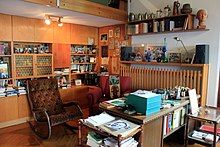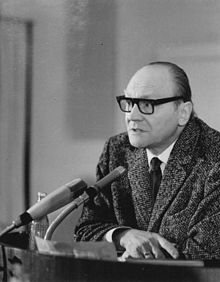Jurij Brězan
Jurij Brězan (born June 9, 1916 in Räckelwitz / Worklecy; † March 12, 2006 in Kamenz / Kamjenc) was a writer who wrote his works (mainly novels , stories and children's books) in both Upper Sorbian and German . He is considered the most important Sorbian writer of the 20th century and the founder of Sorbian socialist literature. His books have been translated into a total of 25 languages.
Life
Jurij Brězan was born in the Räckelwitz Clinic in 1916. The Germanized form of the name Georg Bresan is recorded on the birth certificate, but was never used publicly by Brězan himself. He later officially bore his Sorbian name after this was made possible in the GDR.
From 1928 he attended grammar school in Bautzen , then began studying economics and was excluded from it in 1936. Since 1933 he worked for the Domowina and was active in a Sorbian resistance group. In the meantime he used the pseudonym Dušan Šwik . From 1937 to 1938 he emigrated to Prague . After his return he was arrested and was in prison from 1938 to 1939. From 1942 to 1944 he was a soldier in the Wehrmacht and was taken prisoner by the United States .

1945 to 1948 he was a youth functionary of Domowina and organized the Sorbian youth movement Serbska młodźina ("Sorbian Youth"), as well as the Sorbian youth brigades, which u. a. were active in Yugoslavia . In 1946 he joined the SED . Since 1949 he worked as a freelance writer. In 1964 Brězan became a member of the German PEN Center East and West, and in 1965 of the German Academy of the Arts . From 1969 to 1989 he was Vice President of the GDR Writers' Association . Until his death, Brězan lived near his birthplace Räckelwitz in Dreihäuser / Horni Hajnk .
Brězan received numerous awards in the GDR: in 1951, 1964 and 1976 with the National Prize , 1962 with the Ćišinski Prize , 1973 with the Literature and Art Prize of the Domowina, 1974 with the Karl Marx Order and 1966 and 1981 with the Patriotic Order of Merit (VVO) and 1986 with the gold medal for the VVO.
plant

Many of his novels and stories have autobiographical traits. His best known work in this category is the novel trilogy about Felix Hanusch ( Feliks Hanuš ), consisting of the novels The high school student ( "Šuler" ; 1959), half of lost time ( "Wučbne Leta" ; 1959) and manhood ( "Zrałe Leta" ; 1964).
Other works draw on the rich legends and fairy tales of the Sorbian Upper Lusatia . A recurring figure is the legendary magician Krabat . 1955 translated Brězan Mišter Krabat by Měrćin Nowak-Njechorński under the title Master Krabat the good Sorbian magician into German. Krabat later appears in the fairy tale story Die Schwarze Mühle from 1968 and in the two novels Krabat or The Metamorphosis of the World from 1976 and Krabat or The Preservation of the World from 1993.
Works
- Grain grows on the Rain (1951)
- 52 weeks are a year (novel, 1953; film adaptation 1955 )
- Christa (story, 1957)
- The high school student (novel, Verlag Neues Leben, Berlin 1958)
- The girl Trix and the ox Esau (1959)
- Borbass and the Rod of God (story, 1959)
- Semester of Lost Time (Roman, 1960)
- A Love Story (1962)
- Man years (Roman, 1964)
- The elephant and the mushrooms (children's book, 1964)
- Journey to Krakow (1966)
- The adventures of Mikosch the cat (children's book, 1967)
- The black mill (story, 1968)
- The mouse tower ( short stories, 1971)
- Krabat or The Transformation of the World (novel, 1976)
- Views and Insights (Essays, 1976)
- The rat battle ( short stories, 1977)
- The bridal jewelry (stories, 1979)
- Picture of father (novel, 1982)
- Dalmat is on vacation (children's book, 1985)
- How Laughter Was Born (Stories, 1986)
- Insights and Views (1986)
- Tales of Water (Stories, 1988)
- My piece of time (autobiographical report, 1989)
- Brother Tree and Sister Larch (1991)
- The beautiful blue horse (1991)
- Moja archa Horni Hajnk (1991)
- Krabat or The Preservation of the World (novel, 1993)
- Rifko - from the diary of a dachshund (children's book, 1994)
- The People of Salow (Roman, 1997)
- Without passport and customs (autobiographical report, 1999)
- The green lizard (novel, 2001)
- Hund's diary (story, 2001)
- The invitation (novella, 2003)
- Habakkuk (story, 2004)
- The virgin who didn't want to go to bed (folk tales, 2006)
- The old man and the narrow space (short story, 2006)
literature
- Dietrich Scholze: Jurij Brězan - life and work . Domowina-Verlag, Bautzen 2016, ISBN 978-3-7420-2371-1 .
- Monika Blidy: The little hill, five stalks of corn high. Reality - fiction - imagination in Jurij Brězan's mature creative phase. Neisse Verlag, Dresden 2016, ISBN 978-3-7420-2371-1 .
- Adrienne Eva Muncy: Postmodern Mythology: Ecology, cultural survival, and Sorbian Folklore in the Works of Jurij Brězan, Michigan 2004 (Senior Thesis Eastern Michigan University).
- Bernd-Rainer Barth , Andreas Kölling: Brĕzan, Jurij . In: Who was who in the GDR? 5th edition. Volume 1. Ch. Links, Berlin 2010, ISBN 978-3-86153-561-4 .
Web links
- Official website about Jurij Brězan
- Literature by and about Jurij Brězan in the catalog of the German National Library
- Dietrich Scholze: Brězan (Bresan), Jurij (Georg) (pseudonym: Dušan Šwik) . In: Institute for Saxon History and Folklore (Ed.): Saxon Biography .
Individual evidence
- ↑ Germany Archive , Volume 39, Issues 3–4, p. 403.
| personal data | |
|---|---|
| SURNAME | Brězan, Jurij |
| ALTERNATIVE NAMES | Bresan, Georg (maiden name) |
| BRIEF DESCRIPTION | Sorbian writer |
| DATE OF BIRTH | June 9, 1916 |
| PLACE OF BIRTH | Räckelwitz |
| DATE OF DEATH | March 12, 2006 |
| Place of death | Kamenz |

